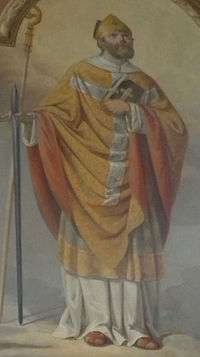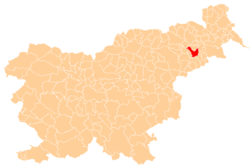Victorinus of Pettau
| Saint Victorinus of Pettau | |
|---|---|
|
Victorinus on a fresco in the parish church of Nova Cerkev (Slovenia) | |
| Bishop of Poetovio and Martyr | |
| Born | Likely in Greece |
| Died |
303 or 304 AD Poetovio (Ptuj) |
| Venerated in |
Roman Catholic Church Orthodox Church |
| Feast | 2 November |
| Attributes | Palm, pontifical vestments |
Saint Victorinus of Pettau or of Poetovio (died 303 or 304) was an Early Christian ecclesiastical writer who flourished about 270, and who was martyred during the persecutions of Emperor Diocletian. A Bishop of Poetovio (modern Ptuj in Slovenia; German: Pettau) in Pannonia, Victorinus is also known as Victorinus Petavionensis, Poetovionensis or Victorinus of Ptuj.[1]
Born probably in Greece on the confines of the Eastern and Western Empires or in Poetovio with rather mixed population, due to its military character, Victorinus spoke Greek better than Latin, which explains why, in St. Jerome's opinion, his works written in the latter tongue were more remarkable for their matter than for their style. He was the first theologian to use Latin for his exegesis. He is one of the earliest church fathers to give any indication against Chiliasm, though he still respects the gathering of the church to Judea. Moreover, his remarks on the twentieth chapter of the Apocalypse stand in contradiction to his commentary on the seventh millennium given in his work On the Creation of the World,[2] possibly indicating a redaction in his Commentary on the Apocalypse,[3] or a change of opinion.
His works were ranked with the apocrypha in the decree, later attributed to Pope Gelasius I, which excluded and anathematized them with that of many other early fathers. That is to say they were not considered free of error.[4] By contrast, St. Jerome gives him an honourable place in his catalogue of ecclesiastical writers. Victorinus composed commentaries on various books of Holy Scripture, such as Genesis, Exodus, Leviticus, Isaiah, Ezekiel, Habakkuk, Ecclesiastes, the Canticle of Canticles, St. Matthew, and the Apocalypse, besides treatises against the heresies of his time.
All his works have disappeared save his Commentary on Apocalypse and short tract On the construction of the world ('De fabrica mundi). It is agreed among scholars, that these texts are really a remnant of his works. The Migne edition, in Patrologia Latina V (1844) 301–344, is considered no more reliable, since the discovery of an important codex by Haussleiter (edition in CSEL 49, 1916), the reference however is to be taken rather from the new critical edition by M. Dulaey in SCh 421 (1997). It is incorrect to regard him as the author of two poems,De Jesu Christo and De Pascha, which are included in the collection of Fabricius.
Victorinus' memorial day in both the Eastern and Western Churches is 2 November. Until the 17th century he was likewise confused with the Latin rhetorician, Victorinus Afer.
Commentary on the Apocalypse
Victorinus was apparently the first of the Church Fathers to ascertain the basic notion of repetition – that the Apocalypse is not one uninterrupted and developing line of prophecy, but rather that various subdivisions run parallel with each other. And he saw that the theme of the soon coming Second Advent was a continuous thread of thought throughout the Apocalypse.[5]
He wrote of the seven churches as representing seven classes of Christians within the church. The seven seals are explained as constituting a prophetic fore view of the spread of the gospel throughout the world. In connection with the Second Advent and the end of the world he looked for wars, famines, pestilences and persecution of the church.
The crowned rider of the four horsemen seated upon the white horse, going forth "conquering, and to conquer," is interpreted as prophetic of Christ's church going forth on its victorious mission, the triumph of Christianity over paganism. The red horse is explained as "coming wars," predicted as salient events preceding the end. The black horse, Victorinus avers, signifies "famines" in the time of the Antichrist. The pale horse meant "coming destructions."[6]
The angel with the seal in chapter 7 symbolizes Elias the prophet as the "precursor of the times of Antichrist." Then comes the kingdom of Antichrist and finally the angel reapers smite the kingdom of Antichrist delivering the saints.[7]
The great red dragon with seven heads of chapter 12 he sees as Rome, from which springs Antichrist in the last times, amid the ten horns. The Antichrist springs from the battle in heaven, and the expulsion and his earthly domination foIlow the three and half years of Elijah's preaching."[8]
The first and second angels of Revelation 14 are the predicted Elias and Jeremiah, witnessing before the Second Advent and end of the world, ushering in the eternal kingdom. The leopard beast of Revelation 14 signifies the kingdom of the time of Antichrist. Victorinus considers the 666 of verse 18 as the computation of letters, each of which comprise the equivalent number, of an assortment of possible names.
After the seven plagues of the last days in Revelation 15, Babylon, in Revelation 17, is identified as Rome seated upon her "seven hills," drunk with the blood of martyrs. The seven heads of the seven-hilled Rome are believed, in their immediate application, to represent seven emperors, the sixth being Domitian, with the eighth who is "of the seven," as Nero. [9] The ten horns of Daniel 7 are equated with those of the Apocalypse, with three of the kings killed by the Antichrist."[10]
Works
Footnotes
- ↑ Erroneously, based on some bad manuscripts, also as Victorinus Pictaviensis. He was long thought to have belonged to the Diocese of Poitiers (France).
- 1 2 "CHURCH FATHERS: On the Creation of the World (Victorinus)".
- 1 2 "CHURCH FATHERS: Commentary on the Apocalypse (Victorinus)".
- ↑ "The Development of the Canon of the New Testament - The Decretum Gelasianum".
- ↑ Froom 1950, p. 338.
- ↑ Froom 1950, p. 339.
- ↑ Froom 1950, p. 340.
- ↑ Froom 1950, p. 342.
- ↑ Froom 1950, p. 343.
- ↑ Froom 1950, p. 344.
References
-
 This article incorporates text from a publication now in the public domain: Herbermann, Charles, ed. (1913). "article name needed". Catholic Encyclopedia. New York: Robert Appleton.
This article incorporates text from a publication now in the public domain: Herbermann, Charles, ed. (1913). "article name needed". Catholic Encyclopedia. New York: Robert Appleton. - Froom, LeRoy (1950). The Prophetic Faith of our Fathers (DjVu and PDF). 1.
External links
| Wikisource has original works written by or about: Victorinus |
- November 2 Feasts at OrthodoxWiki.org
- Victorinus at New Advent Catholic Encyclopedia
- Works of Victorinus
- Victorinus at Catholic.org
- Victorinus at EarlyChurch.org.uk
- Victorinus at SaintPatrickDC.org
- Victorinus at Catholic-Forum.com
- Opera Omnia by Migne Patrologia Latina with analytical indexes

